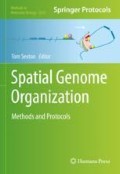Abstract
Hi-C and related sequencing-based techniques have brought a detailed understanding of the 3D genome architecture and the discovery of novel structures such as topologically associating domains (TADs) and chromatin loops, which emerge from cohesin-mediated DNA extrusion. However, these techniques require cell fixation, which precludes assessment of chromatin structure dynamics, and are generally restricted to population averages, thus masking cell-to-cell heterogeneity. By contrast, live-cell imaging allows to characterize and quantify the temporal dynamics of chromatin, potentially including TADs and loops in single cells. Specific chromatin loci can be visualized at high temporal and spatial resolution by inserting a repeat array from bacterial operator sequences bound by fluorescent tags. Using two different types of repeats allows to tag both anchors of a loop in different colors, thus enabling to track them separately even when they are in close vicinity. Here, we describe a versatile cloning method for generating many repeat array repair cassettes in parallel and inserting them by CRISPR-Cas9 into the human genome. This method should be instrumental to studying chromatin loop dynamics in single human cells.
Access this chapter
Tax calculation will be finalised at checkout
Purchases are for personal use only
Change history
14 September 2022
In the original version of this book, Chapter 13 was published with few errors. This has been rectified in the updated version of this book.
References
Rao SSP, Huntley MH, Durand NC et al (2014) A 3D map of the human genome at kilobase resolution reveals principles of chromatin looping. Cell 159:1665–1680
Cardozo Gizzi AM, Cattoni DI, Fiche J-B et al (2019) Microscopy-based chromosome conformation capture enables simultaneous visualization of genome organization and transcription in intact organisms. Mol Cell 74(1):212–222.e5
Bintu B, Mateo LJ, Su J-H et al (2018) Super-resolution chromatin tracing reveals domains and cooperative interactions in single cells. Science 362:eaau1783
Boettiger A, Murphy S (2020) Advances in chromatin imaging at kilobase-scale resolution. Trends Genet 36(4):273–287
Rao SSP, Huang S-C, Glenn St Hilaire B et al (2017) Cohesin loss eliminates all loop domains. Cell 171:305–320.e24
Parmar JJ, Woringer M, Zimmer C (2019) How the genome folds: the biophysics of four-dimensional chromatin organization. Annu Rev Biophys 48:231–253
Fudenberg G, Abdennur N, Imakaev M et al (2017) Emerging evidence of chromosome folding by loop extrusion. Cold Spring Harb Symp Quant Biol 82:45–55
Davidson IF, Bauer B, Goetz D et al (2019) DNA loop extrusion by human cohesin. Science 366(6471):1338–1345
Sikorska N, Sexton T (2019) Defining functionally relevant spatial chromatin domains: it’s a TAD complicated. J Mol Biol 432(3):653–664
Hansen AS, Cattoglio C, Darzacq X et al (2018) Recent evidence that TADs and chromatin loops are dynamic structures. Nucleus 9:20–32
Beagan JA, Phillips-Cremins JE (2020) On the existence and functionality of topologically associating domains. Nat Genet 52:8–16
Chen B, Gilbert LA, Cimini BA et al (2013) Dynamic imaging of genomic loci in living human cells by an optimized CRISPR/Cas system. Cell 155:1479–1491
Alexander JM, Guan J, Huang B et al (2018) Live-cell imaging reveals enhancer-dependent Sox2 transcription in the absence of enhancer proximity. Elife 8:e41769
Mullick A, Xu Y, Warren R et al (2006) The cumate gene-switch: a system for regulated expression in mammalian cells. BMC Biotechnol 6:43
Germier T, Audibert S, Kocanova S et al (2018) Real-time imaging of specific genomic loci in eukaryotic cells using the ANCHOR DNA labelling system. Methods 142:16–23
Cong L, Ran FA, Cox D et al (2013) Multiplex genome engineering using CRISPR/Cas systems. Science 339:819–823
Tasan I, Sustackova G, Zhang L et al (2018) CRISPR/Cas9-mediated knock-in of an optimized TetO repeat for live cell imaging of endogenous loci. Nucleic Acids Res 46:e100
Brandão HB, Gabriele M, Hansen AS (2021) Tracking and interpreting long-range chromatin interactions with super-resolution live-cell imaging. Curr Opin Cell Biol 70:18–26
Schermelleh L, Ferrand A, Huser T et al (2019) Super-resolution microscopy demystified. Nat Cell Biol 21:72–84
Grimm JB, Muthusamy AK, Liang Y et al (2017) A general method to fine-tune fluorophores for live-cell and in vivo imaging. Nat Methods 14:987–994
Author information
Authors and Affiliations
Corresponding authors
Editor information
Editors and Affiliations
Rights and permissions
Copyright information
© 2022 The Author(s), under exclusive license to Springer Science+Business Media, LLC, part of Springer Nature
About this protocol
Cite this protocol
Sabaté, T., Zimmer, C., Bertrand, E. (2022). Versatile CRISPR-Based Method for Site-Specific Insertion of Repeat Arrays to Visualize Chromatin Loci in Living Cells. In: Sexton, T. (eds) Spatial Genome Organization. Methods in Molecular Biology, vol 2532. Humana, New York, NY. https://doi.org/10.1007/978-1-0716-2497-5_13
Download citation
DOI: https://doi.org/10.1007/978-1-0716-2497-5_13
Published:
Publisher Name: Humana, New York, NY
Print ISBN: 978-1-0716-2496-8
Online ISBN: 978-1-0716-2497-5
eBook Packages: Springer Protocols

